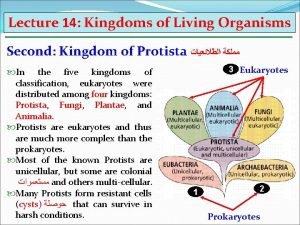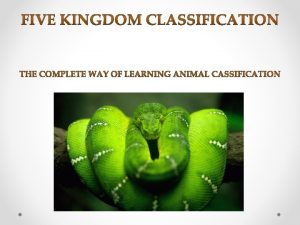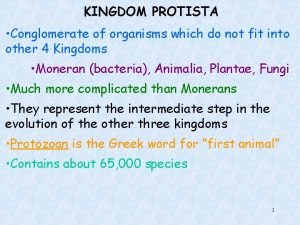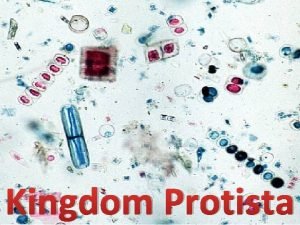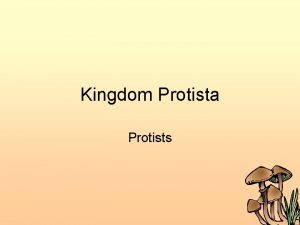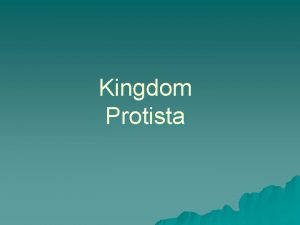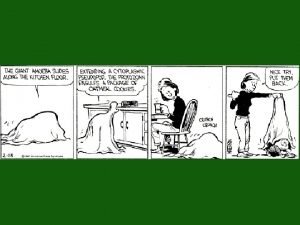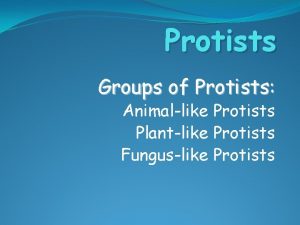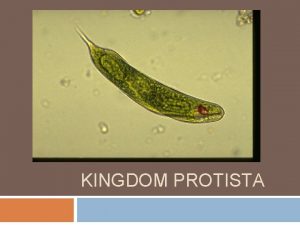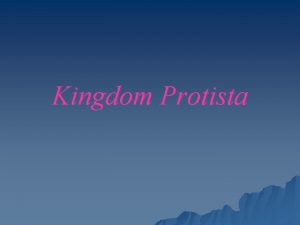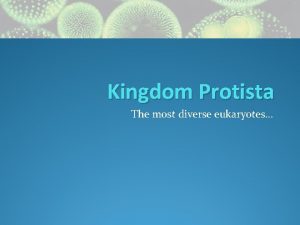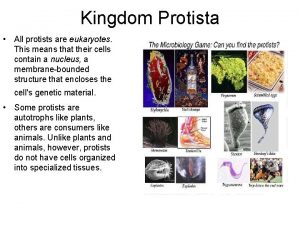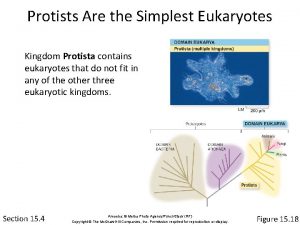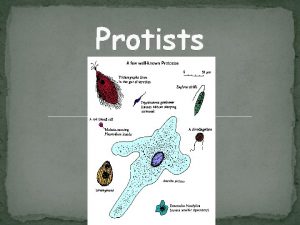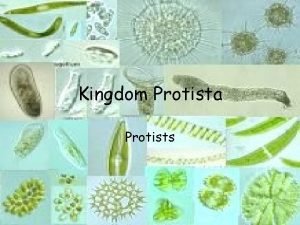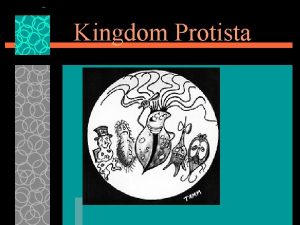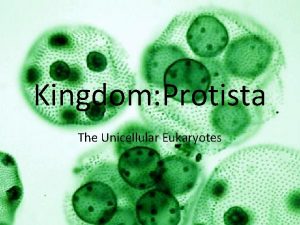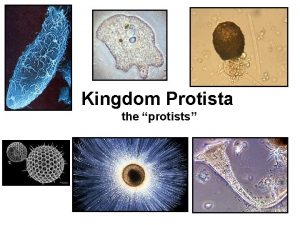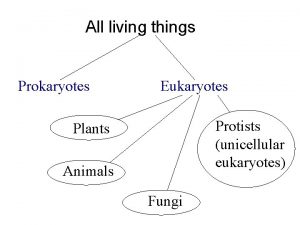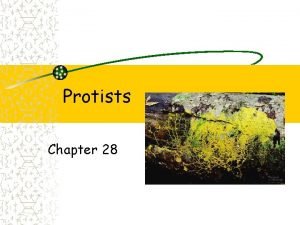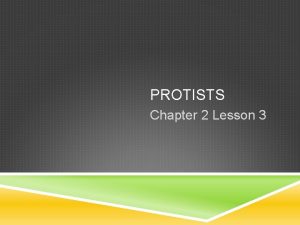Kingdom Protista KINGDOM PROTISTA Protists are eukaryotes that



















- Slides: 19

Kingdom Protista

KINGDOM PROTISTA Protists are eukaryotes that are not fungi, plants, or animals; most are unicellular; found in or near water Examples of Protists: u amoeba – use pseudopodia to move u paramecium – use cilia to move u euglena – use flagella to move u algae – are photosynthetic (ex: green, red, brown algae) u diatoms - are photosynthetic with double shells made of silica u slime and water molds (fungus-like) u sporozoans – form spores (ex: malaria, toxoplasmosis)

Classification of Protists How they obtain energy How they move u Animal Like u Plant Like amoeba euglena paramecium algae sporozoans diatoms u Fungus Like slime mold water mold

Different Kinds Of Protists Amoeba Paramecium Euglena Sporozoans (Malaria) Diatoms Algae Slime & Water Mold

AMOEBA u Pseudopod – flexible cytoplasmic extensions; “false foot” u Contractile Vacuole – removes excess water u Cyst – a hard-walled body that can exist for a long period of time until conditions become favorable

u Method of Reproduction – binary fission u Endocytosis– u Amoebic Dysentery – diarrhea and stomach upset caused by drinking contaminated water method of food intake creating food vacuoles

Euglena u Flagella – a long whip-like structure that acts like a little motor for movement u Eyespot – area that detects light u Contractile Vacuole – removes excess water

u Pellicle – stiff but flexible covering that gives the organism its shape u Autotrophic – have chloroplast u Heterotrophic– absorbs food across to can undergo their cell membrane photosynthesis

Paramecium u Cilia – tiny hairlike projections u Pellicle – a thick outer membrane u Contractile Vacuole – removes excess water u Trichocysts – thread like organelles used as defense mechanisms

Behavio Behavi from an unpleasan u Micronucleus – u Avoidance controls reproduction; asexually (binary fission) or sexually (conjugation) u Macronucleus – controls everything but reproduction

Kingdom Fungi

KINGDOM FUNGI Characteristics: u eukaryotes u multicellular, except for yeast (unicellular) u cell walls are made of chitin u “absorptive” heterotrophs, they do not ingest their food, they secrete digestive enzymes then absorb the nutrients (extracellular digestion) ex: saprophytes – live off dead organisms parasites – live off living organisms

Why are fungi not classified as plants? u They are heterotrophs, not autotrophs. u They have no chloroplast/chlorophyll. u They have no true roots, stems, and leaves.

Internal Structure of Fungi u The bodies of fungi consist of hyphae (long slender strands of cells). A branching network of hyphae is called mycelium.

How do fungi reproduce? u Asexually – cells divide to produce spores or a piece of hyphae breaks off and grows into a new fungus u Sexually – the hyphae of two different fungi grow close together and the hyphae join together producing a genetically different fungi

Types of Fungi: u Club Fungi (Basidiomycetes) – mushrooms; forms spores in a structure called basidium u Sac Fungi (Ascomycetes) – truffles, mildew; forms spores in a sac called asci; also includes yeast u Thread-like Fungi (Zygomycetes)bread mold; spores found in sporangium u Imperfect Fungi ( Deuteromycota) includes Althete’s foot, ringworm, thrush

Symbiotic Relationships u Lichens – symbiotic relationship between algae and fungi u Mycorrhizae – symbiotic fungi that inhabit the roots of plants and help supply them with nutrients

Types of Fungi Zygomycetes Mushrooms (Thread-like Fungi) Basidiomycetes (Club Fungi) Bread Mold Yeast Ascomycetes (Sac Fungi)

Fungi Classification
 Mikael ferm
Mikael ferm Nnn ruled
Nnn ruled Roman empire
Roman empire Capital of egypt during the old kingdom
Capital of egypt during the old kingdom Old kingdom middle kingdom new kingdom
Old kingdom middle kingdom new kingdom Unicellular living organisms
Unicellular living organisms Tôn thất thuyết là ai
Tôn thất thuyết là ai Phân độ lown
Phân độ lown Chiến lược kinh doanh quốc tế của walmart
Chiến lược kinh doanh quốc tế của walmart Sau thất bại ở hồ điển triệt
Sau thất bại ở hồ điển triệt Gây tê cơ vuông thắt lưng
Gây tê cơ vuông thắt lưng Block nhĩ thất độ 2 mobitz 2
Block nhĩ thất độ 2 mobitz 2 Tìm vết của mặt phẳng
Tìm vết của mặt phẳng Thể thơ truyền thống
Thể thơ truyền thống Hãy nói thật ít để làm được nhiều
Hãy nói thật ít để làm được nhiều Thơ thất ngôn tứ tuyệt đường luật
Thơ thất ngôn tứ tuyệt đường luật Classification of protista
Classification of protista Pseudopodia
Pseudopodia Protista examples
Protista examples Respirasi protista
Respirasi protista





